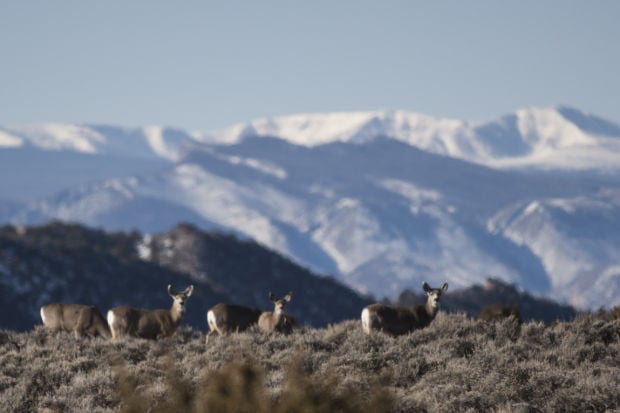Million-dollar study looks at competition between elk and deer
Elk, one of Wyoming’s iconic big game animals, may be out-competing
mule deer for food. And if they are, it means a growing southwest elk
population could be responsible for declining deer numbers.
That’s the theory, anyway. On Sunday, researchers with the University
of Wyoming and Wyoming Game and Fish Department will begin
a five-year project to see if the hypothesis proves true.
“In general, we know deer tend to not like elk,” said Kevin Monteith,
a UW professor and lead researcher on the project.
Researchers also know that deer require higher quality food than
their larger counterparts.
Elk did not historically roam south of Rock Springs in large numbers
, Monteith said. Mule deer reigned king. But a few decades ago, elk
numbers started to rise while deer numbers dropped.
The Muley Fanatic Foundation and Game and Fish have been major
contributors to the $1.4 million study.
“This isn’t just a one-shot-and-you’re-done project,” said Joshua
Coursey, president and CEO of the Muley Fanatic Foundation.
“This is going to be the most truth-telling research project showing
what’s actually happening on the ground.”
Coursey and other sportsmen in the area have long noticed the decline
in mule deer in one of the most prized herds in the state. But this year,
the wildlife advocate drew a coveted license for the area.
His time in the field has reinforced the need to better understand,
and find a solution to, declines, he said.
“I’ve had this firsthand account in the last 13 days to see how poor
that area is represented by mule deer,” he said.
While it is not the first study in the country to look at competition
between elk and mule deer, it is the first to look at a combination
of hunting, habitat condition, drought, predation and competition,
Monteith said.
“We’ve gotten glimpses and pieces,” he said. “But we have yet
to put all those pieces together.”
While it may be a few years before all of the data can be analyzed,
the end result could solve a mystery that has puzzled wildlife
managers and researchers for decades

When Deer and Elk Compete
Deer and elk are closely related species in the Deer
family (Cervidae). They often inhabit similar habitat types in locations where they co-occur. They are also active during the same parts of the day, mainly in the early morning and in the evening. It is not at all uncommon to see them in close proximity, exhibiting no signs of competition and apparently coexisting peacefully.
ELK GRAZING IN SUMMER;THEY BROWSE IN
WINTER
DEER BROSE YEAR ROUND
Deer are browsers. Most of the time they eat leaves, stems,
twigs, and bark. Shrubs constitute about 75% of their diet, and about 25% comes from forbs (non-woody herbs). In contrast, elk tend to graze (eat grasses and forbs) whenever possible. They get 85% of their food from grazing. They often take the most rapidly growing, thus frequently the softest and most nutritious, plants. During most of the year there is no competition for food between deer and elk, because they are using different eating strategies which include different plants or different parts of the same plant.
However, in winter, the peaceful coexistence
scenario shifts. In winter, elk become browsers. This means that in the coldest time of the year, when food may become scarce, deer and elk compete.
It is not an even battle, and it is waged very subtly.
Elk are about two to three times the size of their smaller cousins, the deer. They can easily push deer off prime browsing areas, although direct aggression is exceptionally rare. In good range, in mild winters, when numbers of animals are low to moderate, the competition may not be intense. In areas where food is not abundant, in hard winters, or when animal numbers are high, competition can be severe. In such situations, it is not uncommon to see deer numbers decline |





No comments:
Post a Comment